2017 Shetland Environmental Awards Presented
Published: 17 November 2017
 ZoomShetland Amenity Trust hosted the Shetland Environmental Awards at a ceremony held in the Museum and Archives today. The awards, judged by the multi-agency Shetland Environment Group, acknowledged thirteen local environmental projects demonstrating sustainability, innovation and best practice.
ZoomShetland Amenity Trust hosted the Shetland Environmental Awards at a ceremony held in the Museum and Archives today. The awards, judged by the multi-agency Shetland Environment Group, acknowledged thirteen local environmental projects demonstrating sustainability, innovation and best practice.
Ruth Mackenzie, Chair of Shetland Amenity Trust, said: “The awards have always been truly inclusive, attracting nominations for a wide variety of projects from all sectors of the community and this year is no exception. The 13 winners include individuals passionate about the environment, companies increasing their environmental credentials and schools and community groups taking the lead in recycling.
The Shetland Amenity Trust has been involved in many of these projects, showing just how committed we are to protecting and enhancing Shetland’s environment as well as supporting our local community to achieve their environmental objectives.
On behalf of the Shetland Amenity Trust, I would like to thank the Shetland Environment Group for its continued support of the awards.
Finally, I would like to pass on my personal congratulations to all this year’s winners”
Mr Malcolm Roughead, VisitScotland Chief Executive, presented the winning projects with their awards: “I was delighted to be asked to present the awards today and would like to congratulate all the worthy winners.
Shetland’s windswept landscape, unique scenery, and wildlife is part of what attracts thousands of visitors each year, but with that comes a responsibility to look after our environment.
Sustainable tourism aims to ensure that economic development as a result of tourism is a positive experience for everyone involved; local community, tourism businesses and visitors and this is evidenced by these winners today.”
 Zoom This year’s awards were sponsored by the major players within the environment sector in Shetland, including Scottish Environment Protection Agency, Scottish Natural Heritage, Shetland Islands Council, Royal Society for the Protection of Birds, Shetland Civic Society, VisitScotland, Shetland Bird Club and Shetland Amenity Trust. The awards plaques were sponsored and supplied by Cunningsburgh based Enviroglass, which recycles Shetland’s waste glass.
Zoom This year’s awards were sponsored by the major players within the environment sector in Shetland, including Scottish Environment Protection Agency, Scottish Natural Heritage, Shetland Islands Council, Royal Society for the Protection of Birds, Shetland Civic Society, VisitScotland, Shetland Bird Club and Shetland Amenity Trust. The awards plaques were sponsored and supplied by Cunningsburgh based Enviroglass, which recycles Shetland’s waste glass.
The winners of the Shetland Environmental Awards are:
Augean North Sea Services (Shetland) for the Voar Redd Up Partnership
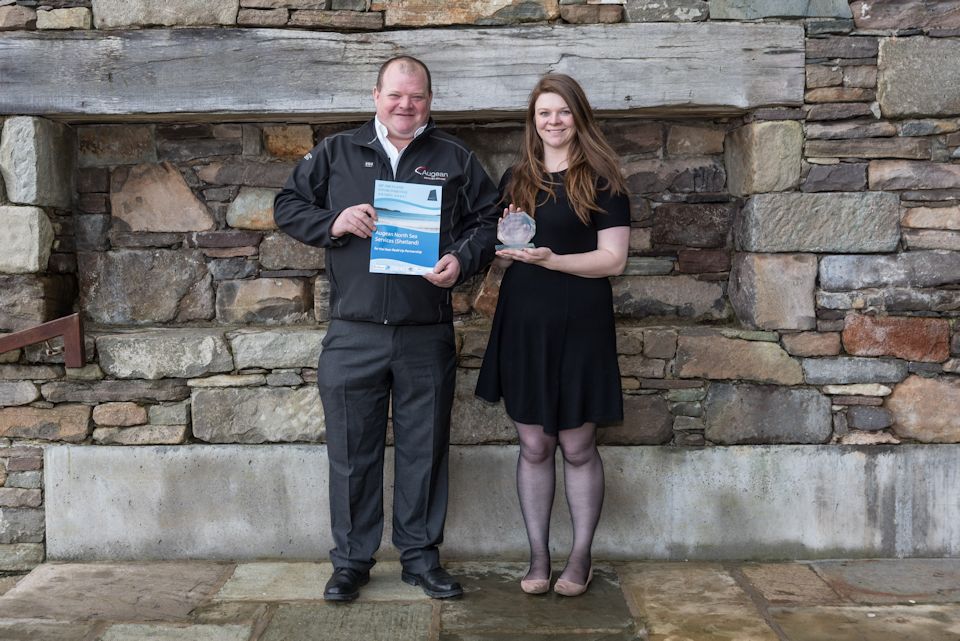 Supporting Da Voar Redd Up in 2016 and 2017, Augean North Sea Services has enabled bruck collected by Redd Up Volunteers to be recycled on a large scale for the first time. In addition to providing their recycling services, they have also provided assistance in collecting Redd Up bruck, given a financial donation to support the Redd Up and taken part in Redd Ups.
Supporting Da Voar Redd Up in 2016 and 2017, Augean North Sea Services has enabled bruck collected by Redd Up Volunteers to be recycled on a large scale for the first time. In addition to providing their recycling services, they have also provided assistance in collecting Redd Up bruck, given a financial donation to support the Redd Up and taken part in Redd Ups.
Although small, consisting of just 3 employees, the Shetland team are very supportive and go above and beyond to help the Shetland Amenity Trust in delivering this community initiative. This has enhanced the environmental credentials of Da Voar Redd Up significantly and enabled Redd Up bruck which could not be recycled before to be diverted from landfill for the first time, including a great deal of marine litter.
From just the 2016 and 2017 Redd Ups, Augean have diverted over 36 tonnes of recyclable Redd Up bruck from landfill. They also work with the Trust out with the main Redd Up period to recycle any ghost nets which come ashore or plastic items from the many Redd Ups which are carried out throughout the year.
Augean’s involvement is not to make money but to support a local community event, show the importance of viewing waste as a resource and, in doing so, promote and explore recycling possibilities in Shetland.
Augean have already proven to be a superb addition to Shetland's environmental economy. Their investment in the local area is important as they see not just the inherent value of waste, and find/facilitate appropriate reuse and recycling routes for it, but also the value of community environmental initiatives such as Da Voar Redd Up. Augean and the Shetland Amenity Trust will continue this successful partnership into the future.
Baltasound Junior High School for the Hermaness Peatland Restoration Project
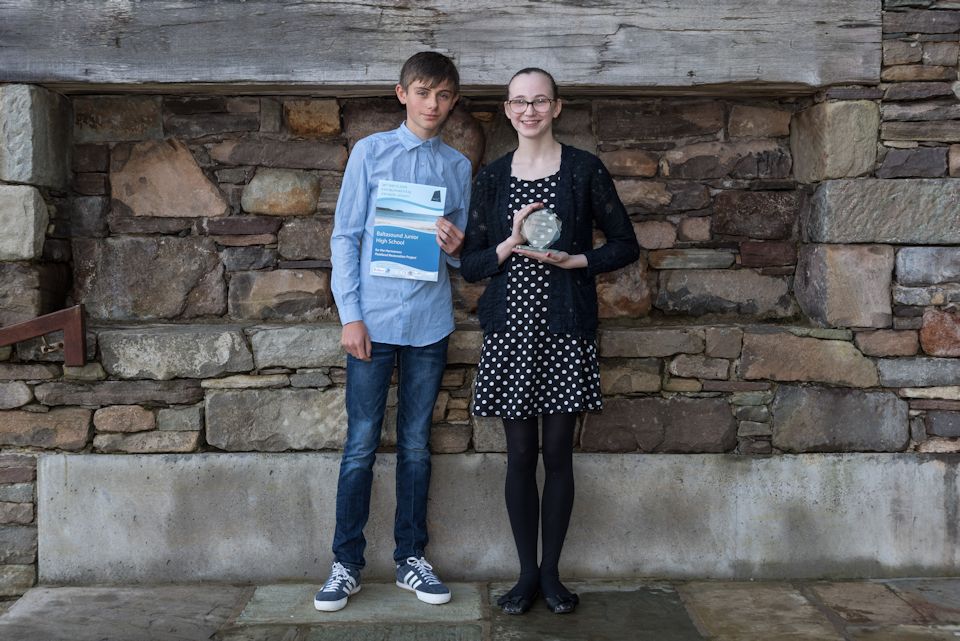 The old path, which went through the middle of the Hermaness National Nature Reserve, had become quite badly eroded, with visitors now advised to keep to the new path and coast. As part of their John Muir Award, Baltasound Junior High School (BJHS) pupils led a Peatland Restoration project to repair the damaged bog.
The old path, which went through the middle of the Hermaness National Nature Reserve, had become quite badly eroded, with visitors now advised to keep to the new path and coast. As part of their John Muir Award, Baltasound Junior High School (BJHS) pupils led a Peatland Restoration project to repair the damaged bog.
With support from Shetland Amenity Trust’s Peatlands Project Officer and Woodlands Team, peatland restoration has followed established guidelines from SNH, and included blocking erosion gullies and ditches – often using recycled materials, repairing bare peat and undertaking a peat depth survey. While the School set aside several days throughout the year, the “Conserver” group has also undertaken work in their own time.
Peatlands, of which blanket bog is an example, are hugely important and a much overlooked habitat. Half of Shetland is covered in blanket bog but it is estimated 70% of this is damaged, which can result in the bog emitting greenhouse gasses, contributing to climate change. Blanket bog forms the main habitat at Hermaness, covering more than 600ha, nearly two thirds of the Reserve. The BJHS Peatland Restoration work will enable bog vegetation to recover and start to absorb CO2 again, as well as improve this internationally important wildlife habitat and the landscape quality of the Reserve.
The peat depth survey will be incorporated into the Scotland Soils Database, http://soils.environment.gov.scot, and contribute to a Scottish Government initiative to better understand Scotland’s peatlands and other soils. Measurements have shown that the peat at Hermaness is about 2.5m deep, representing 2500 years of peat growth.
So far the areas along and around the first 500m of the old path have been restored. The School has set aside more John Muir Award days for the coming school years to continue this fantastic work along the remainder of the path.
Chris Harris for Working with the Skerries Community to clear up the island
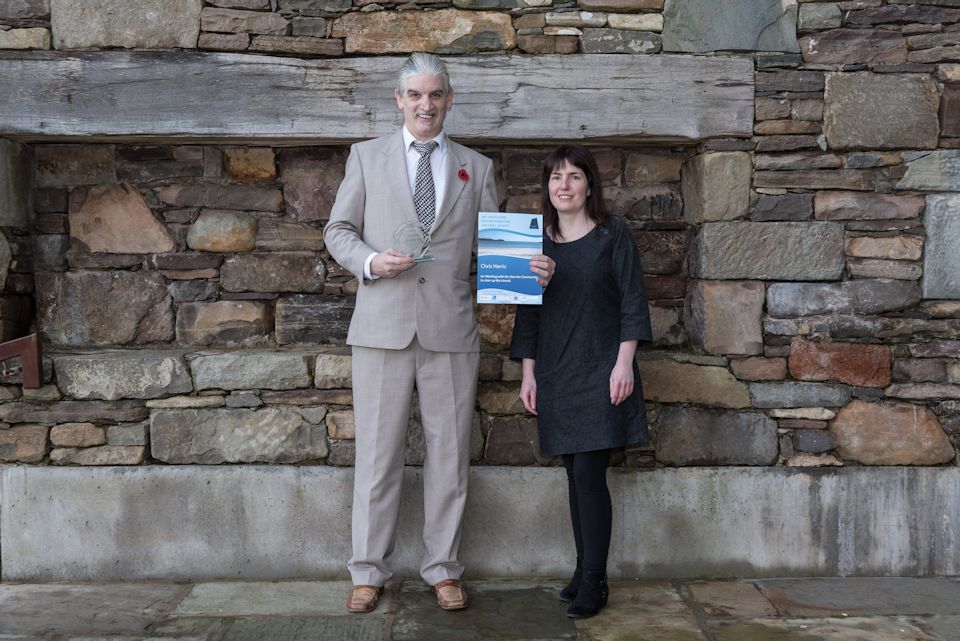 Since moving to the isle in January 2016, Chris Harris has been pivotal in bringing the Skerries community together to help improve the island. For many years the island had been gathering redundant items, such as containers, vehicles, boats, fishing equipment, portakabins, garden sheds, walkways and other items associated with the aquaculture industry. All of this bruck made the island look unsightly and many comments had been made by tourists and locals visiting the isle. With an elderly community, many residents were no longer able to move heavy items and at a loss as to how to go about clearing these items.
Since moving to the isle in January 2016, Chris Harris has been pivotal in bringing the Skerries community together to help improve the island. For many years the island had been gathering redundant items, such as containers, vehicles, boats, fishing equipment, portakabins, garden sheds, walkways and other items associated with the aquaculture industry. All of this bruck made the island look unsightly and many comments had been made by tourists and locals visiting the isle. With an elderly community, many residents were no longer able to move heavy items and at a loss as to how to go about clearing these items.
Chris was instrumental in engaging the community and inspired them to get the island cleaned up. If he was faced with an issue he found a solution – no paperwork for redundant vehicles, he contacted the DVLA for replacements; items he could not find a disposal route for or items no longer required on the island but still usable, he put online to see if it could be sold or given away; no equipment on the isle to handle bigger items and the costs associated with shipping off island, he worked with the Community Council to source funding for machinery and transport costs.
He also re-energised the community in other ways. For example he has turned parts of his home into community spaces, including a cinema, spa, gym and observatory – all made with second hand items he has travelled the length of the UK to collect and installed himself! He also holds community events, such as his annual Crazy Chris Quiz – which by all accounts is much more than a quiz, it’s an afternoon you will never forget….
Julia Barton for the Shetland phase of her Littoral Sci:Art Project
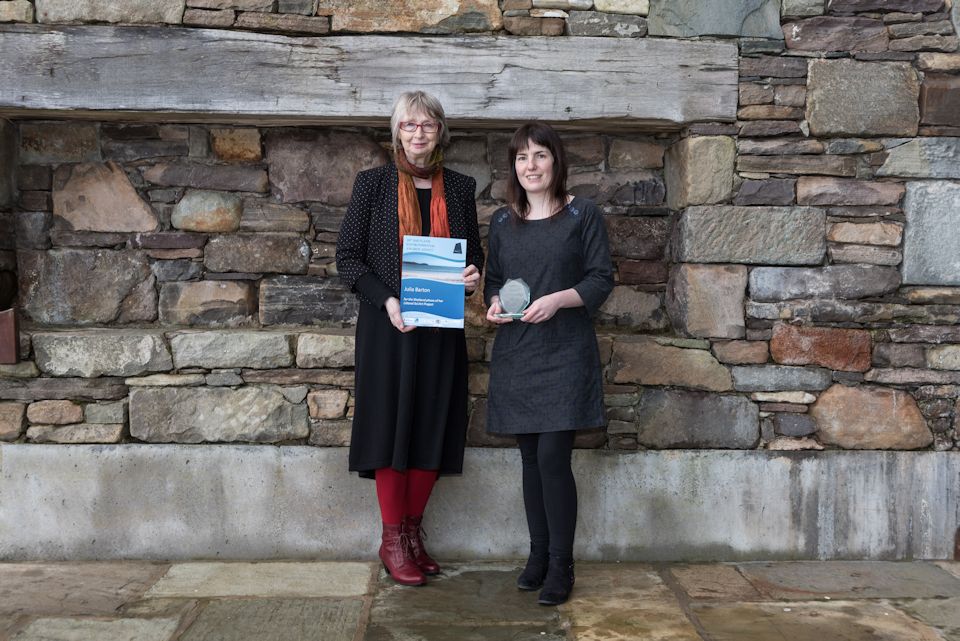 Artist Julia Barton started The Littoral Project in 2013, in response to increasing litter found on beaches. Julia spent spring 2016 working with Shetland Amenity Trust, delivering three workshops to 15 schools, involving 227 pupils from primary 1 to Secondary 4:
Artist Julia Barton started The Littoral Project in 2013, in response to increasing litter found on beaches. Julia spent spring 2016 working with Shetland Amenity Trust, delivering three workshops to 15 schools, involving 227 pupils from primary 1 to Secondary 4:
Lower to mid primary pupils hunted for pre-made fossils, which they broke open to show beach litter and reflected on where they would be in their lives when these materials start to break down. Upper primary pupils carried out CSI-style beach investigations collecting and recording litter samples in 'evidence bags'. The evidence was then returned to manufacturers, urging them to consider the environmental impact.
Secondary pupils mapped small areas of beach, collecting samples to record the abundance of microplastics. They then researched the implications of microplastics for marine organisms and products containing microplastics.
Whilst on the beaches, Julia and the children also collected Plastiglomerates, lumps of melted plastic bonded with natural materials which look like rocks. These have been acknowledged by scientists as a marker of human pollution on the geological record. Julia posed the question: just as they currently learn about the Stone and Iron Age, did they think their descendants may learn about this time period as the plastic age?
Work continued following the initial workshops, with pupils creating larger classroom based projects and Julia developing an exhibition to show in Da Gadderie October - November 2016. During the exhibition, pupils visited for follow up workshops, including sharing their work with Julia, viewing the exhibition and undertaking activities, the last of which was to name geological features on ‘Hope Island’, based on actions they thought could help turn the tide on marine plastics.
Lerwick Port Authority for the Fendering System at Mair’s Pier, Lerwick
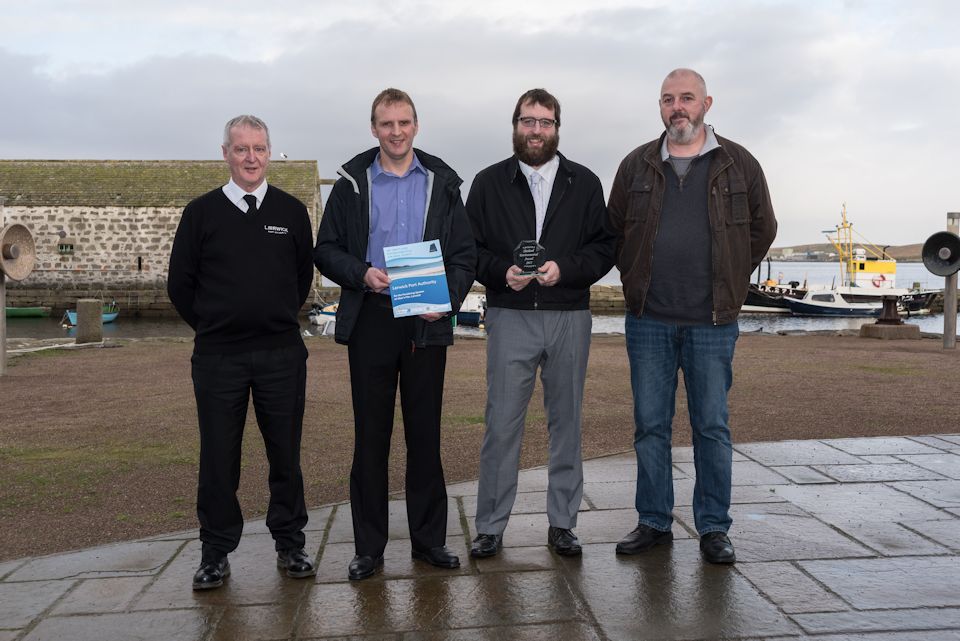 Traditionally fendering systems use typical products available on the market. These systems usually originate in China so have to travel great distances and are expensive to buy, install and maintain, with frequent maintenance and contractors required to work in tidal zones.
Traditionally fendering systems use typical products available on the market. These systems usually originate in China so have to travel great distances and are expensive to buy, install and maintain, with frequent maintenance and contractors required to work in tidal zones.
When the 800-metre-plus Mair’s Pier was designed, Port Authority staff proposed a bespoke, in-house solution, using two sizes of recycled tyres. On the inside of the pier, used by the fishing fleet, truck tyres were hung two deep, while on the outside faces, used by bigger vessels, larger earth-moving machinery tyres were hung in an alternate “zig zag” pattern. Attached by brackets and chains, installation was rapid and did not require tidal working.
This simple solution has a number of benefits, including reduced delivery distance, recycling over 86 tonnes of tyres, savings in procurement, and cost-effective, practical maintenance.
With local sourcing of materials where possible, the supply of the larger tyres in Shetland and then Scotland was used up, with final deliveries coming from England. The project required 215 240-kilogram larger tyres and 580 60-kilogram tyres, totalling more than 86 tonnes diverted from landfill.
In terms of lifespan, historic smaller tyre fenders have proven to be much more durable than traditional fendering systems. The most common failure of a tyre fender is a tyre falling off, which can be retrieved and re-fixed. If tyres ever require replacement, local suppliers know the LPA have a use for used truck and earth moving equipment tyres.
The Port Authority estimates that the bespoke fendering solution saved hundreds of thousands of pounds on the cost of developing Mair’s Pier. In addition, there has been very positive feedback from vessel operators using the pier. In fact, this fender was so successful a similar tyre fender system was installed at Dales Voe quay.
Nesting Primary for their Gutter Keetchin
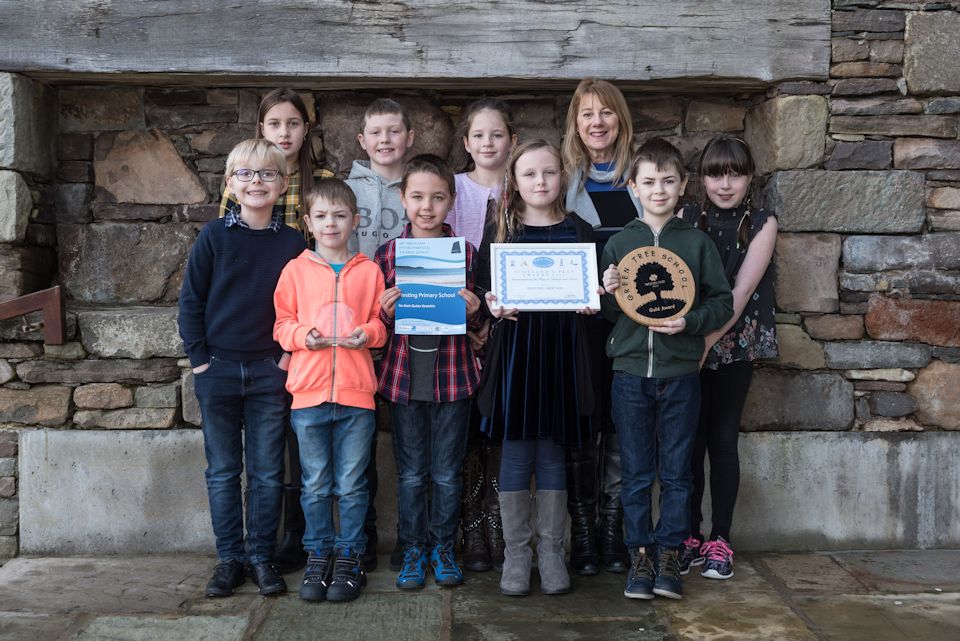 Nesting Primary has turned a vacant part of the school grounds into a creative play area by building a Gutter Keetchin from recycled materials obtained from the wider community. Along with the new council playpark, it is an extension of the work already completed in the grounds and develops Nesting as an outdoor play experience for all Shetland families. It also provides another play area for folk using the nearby caravan site.
Nesting Primary has turned a vacant part of the school grounds into a creative play area by building a Gutter Keetchin from recycled materials obtained from the wider community. Along with the new council playpark, it is an extension of the work already completed in the grounds and develops Nesting as an outdoor play experience for all Shetland families. It also provides another play area for folk using the nearby caravan site.
The school had a great response to social media and email requests highlighting what was required to build the kitchen. Dads got really involved, with one father constructing a tuned percussion instrument from old copper pipe. Local businesses also donated materials and anything not used went to the scrap store at the Auld Skule in Nesting to help support the Heritage group.
The Gutter Keetchin idea was based on scaling up the historic playhouses made out of pallets, where many a long hour was spent making soup and dinner. Their hoose takes up 70m2 and can accommodate over 20 children of all ages in the space. There are pots, pans, utensils, cups and water. Half barrels of recycled material are used for creative play, ropes and net have been used as decoration and it even includes a shop.
The Gutter Keetchin was so well used over the summer the grass was worn away. Other schools are now developing similar projects and individual parents creating peerie hoosies for their bairns at home.
As it is all recycled maintenance costs are low. Many users also bring things to donate, with a store of replacement utensils and pots.
The Gutter Keetchin is open to everyone, and the schools facebook page shows people from all over Shetland using it. It has improved play facilities for many young families and brought visitors into Nesting.
Scottish Water for their Sandy Loch Peat Restoration work
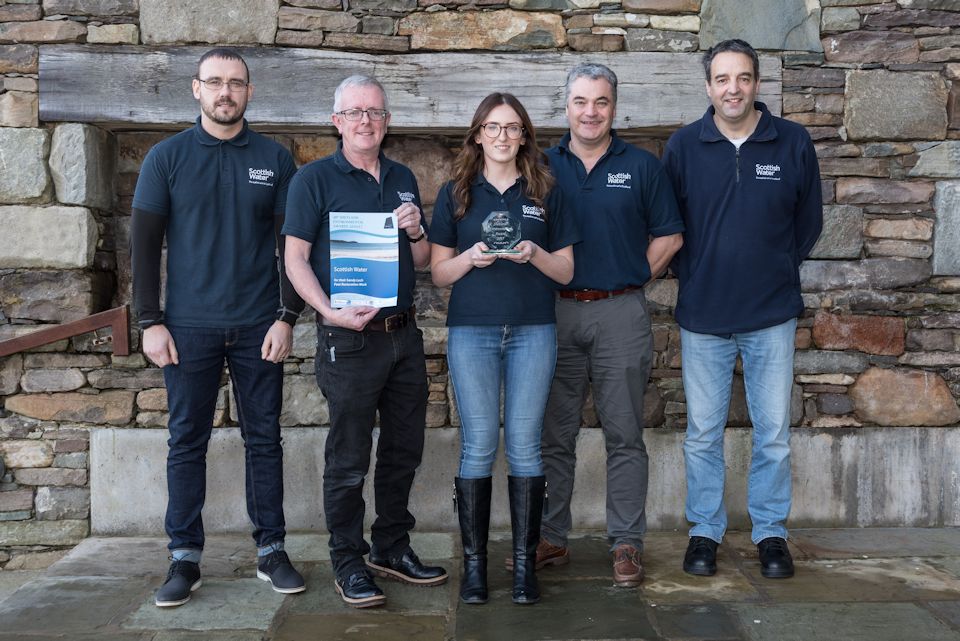 Sandy Loch serves 12,000 customers across the island via the Sandy Loch Water Treatment Works (WTW). A pro-active catchment investigation by the Scottish Water Sustainable Land Management (SLM) team at the start of the year identified large areas of exposed peat at Sandy Loch.
Sandy Loch serves 12,000 customers across the island via the Sandy Loch Water Treatment Works (WTW). A pro-active catchment investigation by the Scottish Water Sustainable Land Management (SLM) team at the start of the year identified large areas of exposed peat at Sandy Loch.
Degrading peat-land is a well-known issue for fresh water reservoirs and the exposed peat at Sandy Loch had been contributing to high levels of colour in the water for years. As peat erodes it seeps into the water supply bringing with it high levels of dissolved organic carbon (DOC) which affects the water treatment process. This means the WTW is forced to use more energy and chemicals to treat the water to ensure it reaches the quality customers expect.
It is also recognised that peat is a precious commodity in our environment, providing incredible biodiversity and playing a potentially significant role in capturing and holding carbon that could otherwise contribute to climate change.
Therefore, the SLM team worked closely with landowners, S. Mackenzie Plant Ltd, the Shetland Amenity Trust and Scottish Natural Heritage to provide a solution that delivered both improved raw water quality and a significant environmental boost.
With the works undertaken, Scottish Water were able to begin the process of rolling back the erosion, restoring the peat to prevent the ground from future erosion and helping create conditions for new peat to form. This increases carbon storage and helps aid biodiversity.
The peatland restoration took place in March 2017 and was completed in under four weeks. Total costs for the project was funded by Scottish Water, carried out as part of their Catchment Management programme.
Shetland Amenity Trust for the Community Cash for Cans Recycling Scheme
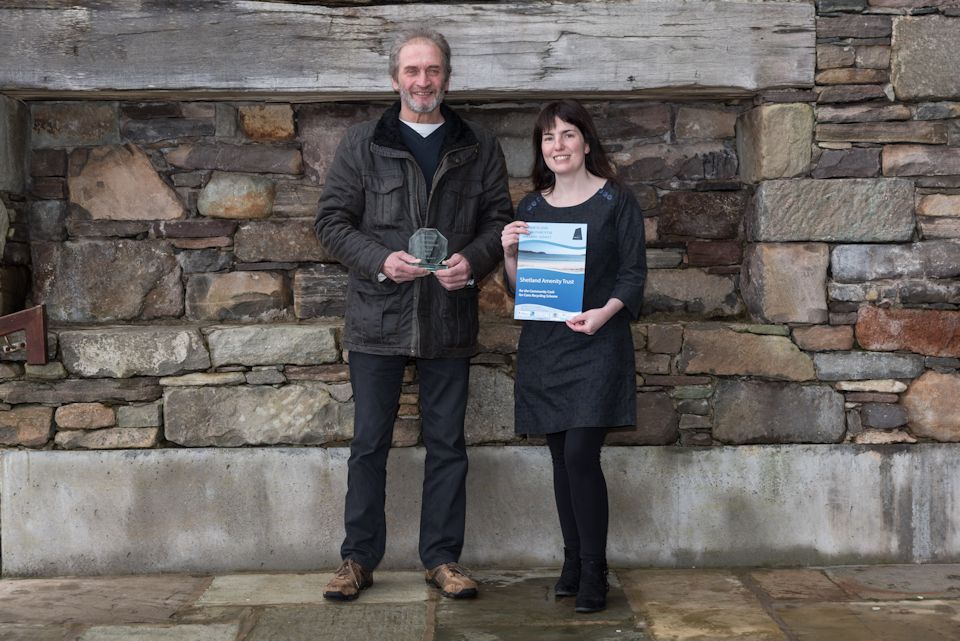 Started in 1989 as a pilot project in schools, the Shetland Amenity Trust Cash for Cans scheme quickly grew and is now a well-established income source for a range of local schools, community groups and charities. It currently has 55 members who collect steel and aluminium cans for recycling which the Trust then sorts, bales and palletises, ready for recycling.
Started in 1989 as a pilot project in schools, the Shetland Amenity Trust Cash for Cans scheme quickly grew and is now a well-established income source for a range of local schools, community groups and charities. It currently has 55 members who collect steel and aluminium cans for recycling which the Trust then sorts, bales and palletises, ready for recycling.
Groups are paid 50p per kg of aluminium cans collected. The funds are paid to the group, or their nominated charity, when the cans are sold.
Many of the community groups and schools involved in the scheme work in partnership with local businesses to collect the cans generated by those businesses for recycling, with the funds being paid to the local group. This enables businesses to support local groups/charities and the group/charity to raise vital funds.
There are many benefits to the scheme, including:
- The recycling of hundreds of tonnes of steel and aluminium cans
- It encourages local groups to collect and recycle
- It encourages businesses to recycle, as they are supporting local groups
- It educates people that waste is a resource which we can be kept in our economy rather than disposed of
- By sorting/processing the cans locally it enables Shetland Amenity Trust to generate the maximum amount of income from this waste and so raise significant funds for local schools, community groups and charities.
Shetland Amenity Trust works with national recycling agencies, such as every can counts and alupro. Annual running costs for the scheme are part of the Trust’s core services, funded through the Shetland Charitable Trust. Income generated when cans are sold cover payments to members of the scheme, shipping costs and materials/equipment for the scheme.
Shetland Community Bike Project for its Continued Environmental Work
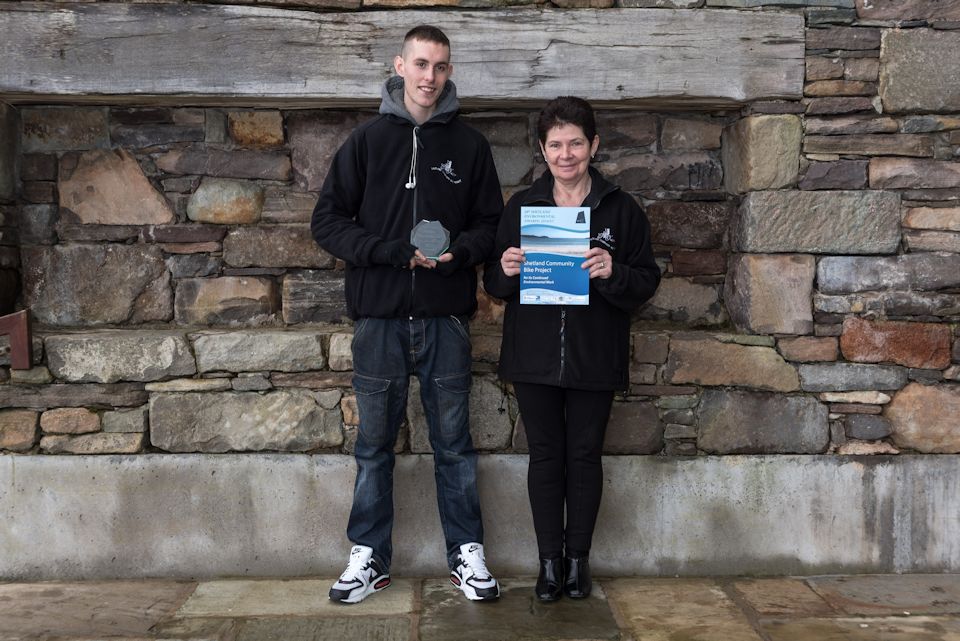 The Shetland Bike Project was established in 1999 as a non-profit making charity to benefit the whole community by promoting recycling, waste minimization and reduction of carbon emissions.
The Shetland Bike Project was established in 1999 as a non-profit making charity to benefit the whole community by promoting recycling, waste minimization and reduction of carbon emissions.
The project services all bike types and models and accepts donations of bikes in any condition to rebuild or strip down. While it is heavily dependent on funding from external agencies, it also generates income through the sale of donated bikes and parts to help support the project. Therefore, it not only provides a local route for repairing and recycling bikes but also a local outlet for reconditioned bikes at affordable prices.
Cycling is a very energy-efficient form of travel, it is good fun and good exercise for all ages. The bike project is passionate about helping people get active. As part of this, they offer bike repair and maintenance classes to groups, which encourage road safety and confidence in both new and experienced cyclists.
As it is operated by people who have barriers to employment, the project is also hugely beneficial to its clients. In fact, it was recently chosen as an example of best practice for the whole of Scotland for the way it supports and helps its clients obtain training and employment.
Since 2010 the project has recycled 142.54 tonnes of material and repaired 2,498 customer bikes. It has also received 2,132 bike donations and sold 1,327 bikes.
The Shetland Bike Project works with various agencies to create employment and skills development in an environmentally friendly way. Funding for the project is received from Shetland Alcohol Drug Partnership, Fairer Shetland Fund and Community Jobs Scotland. Other funding, e.g. ZetTrans, Tesco Bags for Help, Cycling UK and Cycling Scotland, is obtained for individual projects.
Shetland Seed Library for Promoting and Encouraging Seed Saving
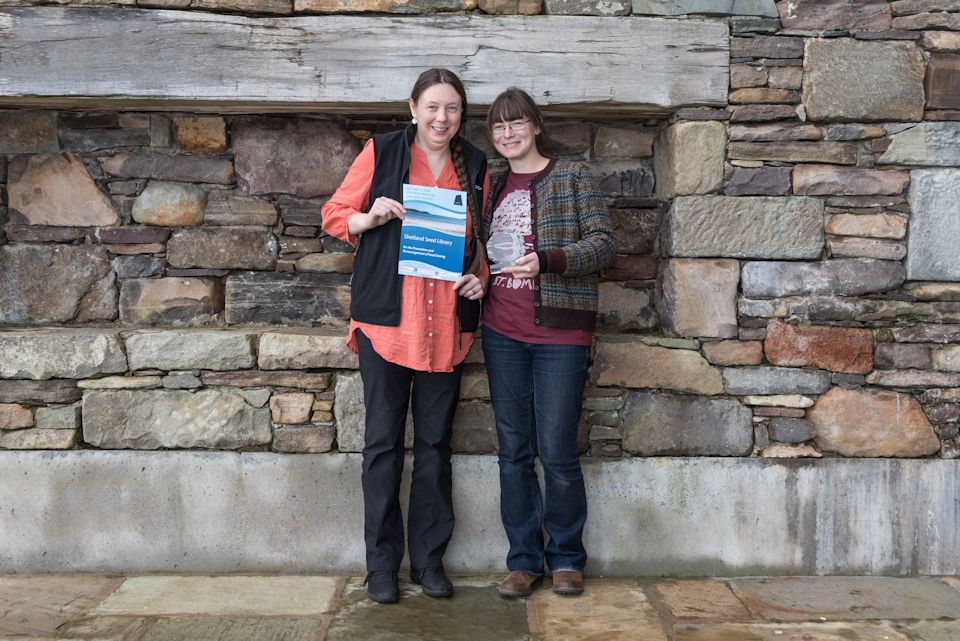 Launched in March 2015 by Aurore Whitworth, The Shetland Seed Library promotes and encourages the skill of seed saving in Shetland. Gardening in Shetland, especially outdoors, can be challenging and saving our own seeds means creating, generation after generation, a plant more adapted and therefore more resilient in our specific climate.
Launched in March 2015 by Aurore Whitworth, The Shetland Seed Library promotes and encourages the skill of seed saving in Shetland. Gardening in Shetland, especially outdoors, can be challenging and saving our own seeds means creating, generation after generation, a plant more adapted and therefore more resilient in our specific climate.
Shetland growers used to save seeds, especially cabbage, kale, neeps, and tatties. Families had their own strain of plants and if someone had a crop failure one year, they could borrow seeds from neighbours for the next. Most of these have disappeared, as people lost interest in growing their own, and saving seeds. The Shetland Seed Library aims to rekindle that interest and help Shetland communities to be more self-reliant again.
The Seed Library has a website: http://shetlandseedlibrary.co.uk/ and Facebook page: https://www.facebook.com/groups/540759086060450/, where tips are shared and seed sharing events advertised. A seed swap is organised every year so local folk can swap and share their seeds. There is also a seed borrowing box in the Shetland Library, Lerwick. This box of seeds is displayed alongside books on growing your own and seed saving, allowing people to ‘borrow’ seeds at the same time as the books. Then, when the plants grow, they produce their own seeds to return to the library.
The project was created with assistance from the Heritage Seed Library, who kindly donated seed packets. It is important that heritage seeds are used, as hybrid seeds will not produce the same plants year on year and many are also treated or modified.
Aurore wants people to realise how important it is to save seeds, because if you control your seeds you control your sustenance. Also, a plant that makes seeds is a plant that has succeeded, and that means a lot in a place like Shetland.
St John’s Kirk, Baltasound for their Trees and Garden Project
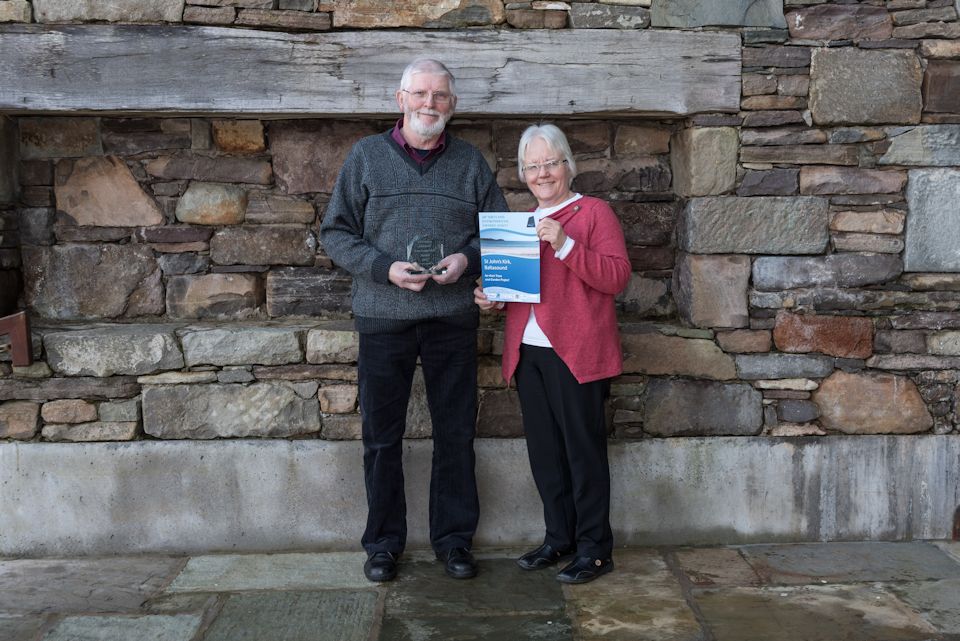 Volunteers from all over the island of Unst came together to develop the garden area at St John’s Kirk, Baltasound and plant 200 trees in glebe land surrounding the church.
Volunteers from all over the island of Unst came together to develop the garden area at St John’s Kirk, Baltasound and plant 200 trees in glebe land surrounding the church.
The garden project incorporated many recycled items, including materials from the Enviroglass peace pole garden at the former Uyeasound School, the kirk’s old bell cradle, a stone sculpture from the original roof and reused stone from the remains of the original 19th century kirk, which were used to build a new garden wall.
A new setting, capturing the essence of Unst in the shape of a boat, was created along with a seating area and an information board using recycled materials. The soil in the lawn is very shallow and of poor quality but is enough to sustain a wide variety of wild flowers, which are left to grow and compliment the cultivated flower border along the outer walls. This border is sustained using compost from the kirk’s own bin.
The glebe land on the west and the east of the kirk has been planted with a variety of trees sourced from the Community Projects arm of the Woodland Trust in the hope of establishing a small scale woodland. Many of the trees were planted with a view to encouraging bird life into the area and have been planted to allow accessibility via paths starting at the car park. As the trees have grown, tube shelters have been replaced by netting made from old oyster bags from a local redundant oyster farm.
The garden and trees are open to the public at all times and looked after by members and friends of the congregation at St John's Kirk, which ensures the sustainability of the project.
Unst Partnership for their Community Skip Scheme
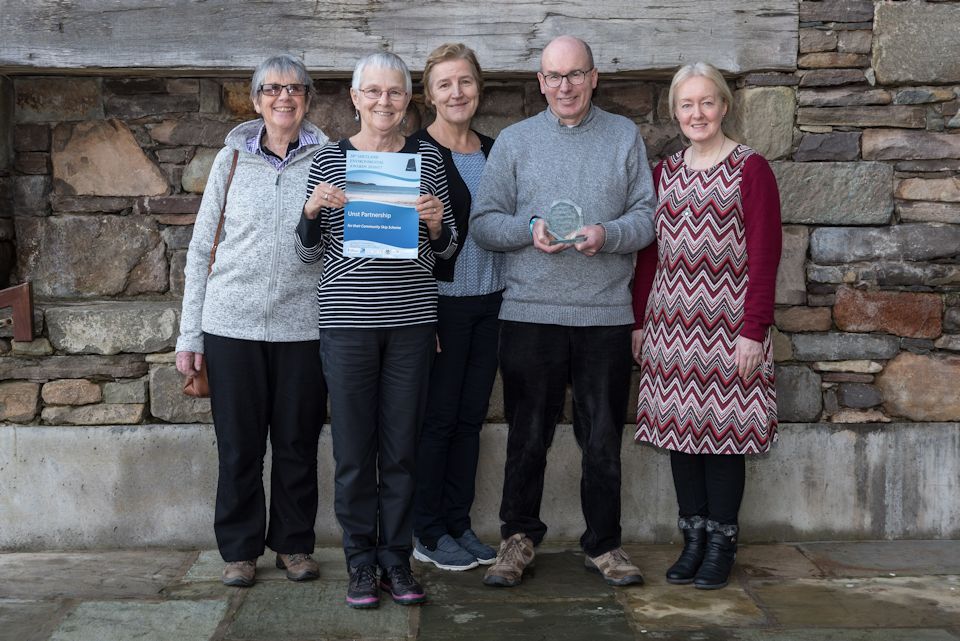 Following the removal of the SIC community skip scheme, the Unst Partnership established their own local scheme to help islanders dispose of bulky items.
Following the removal of the SIC community skip scheme, the Unst Partnership established their own local scheme to help islanders dispose of bulky items.
The Partnership undertook a trial in late 2014 to gauge community interest and, following this, funding was sourced to make it a regular event. The scheme now takes place on 6 Saturdays through the year and no longer receives any subsidy, apart from a small donation from the Unst Community Council. The scheme helps to reduce the amount of waste around the island and discourage fly-tipping on land or at sea. The partnership also offers a trailer uplift service for islanders who do not have the means to either remove the bulky items for their home or transport the goods to the skip location.
Sited at Baltasound Pierhead, a fairly central position on the island, islanders can take their own waste to the skip or utilise the trailer uplift service. Skip users pay a £50 annual sub or £20 for a one off drop. The scheme is well supported with over 40 annual subs and approximately 30 casual users, which covers the costs of the scheme.
Unst Partnership work with Garriocks Ltd, Shetland Amenity Trust and Unst Community Council to deliver the scheme. The project is sustainable as long as there are enough people to support it.
Whalsay School Eco-group for their Environmental Work
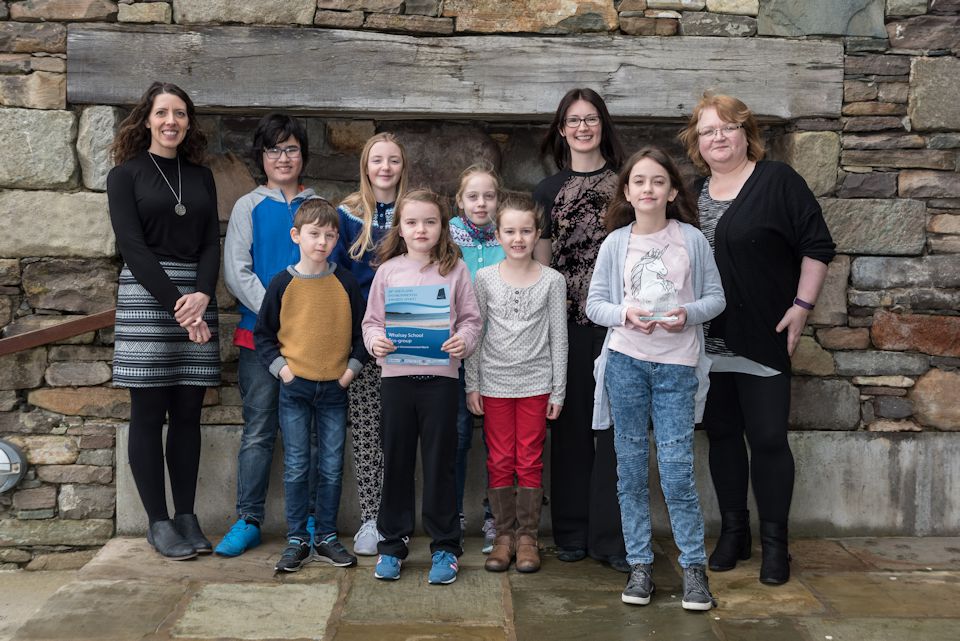 Although relatively new, the Whalsay School Eco-group has worked very hard over the past year to deliver a range of environmental initiatives, including:
Although relatively new, the Whalsay School Eco-group has worked very hard over the past year to deliver a range of environmental initiatives, including:
- Promoting local recycling through creating an information point in the school where staff and the community can see where to recycle glass, batteries, cans, shoes and textiles in Whalsay.
- Working with local shops, distributing bag back boxes from the Shetland Amenity Trust, to encourage the reuse of plastic bags on the isle.
- Using their friend the Green Goblin to help promote their Eco code, reminding everyone to turn off lights when they are not needed, put their litter in the bin and to turn off taps.
- Giving the school grounds a face lift, including creating a lovely fairy garden and tyre flower planters.
- Collecting plastic lids from the Whalsay community to create a bottle top mural. Through this they designed the boards, recycled the tops and engaged their parents help in creating the murals.
- Taking part in Da Voar Redd up, collecting 10 bags of rubbish from the Hamister beach.
- Carrying out regular litter checks at break times around the school grounds.
The Eco-group meets every fortnight in the school term, with the children taking the lead in developing eco-friendly projects which benefit the school and engages the community. The 7 Eco-group members represent each primary class and as this is a school initiative, with annual renewal of membership, it is sustainable.
The Eco-group also received funding from the Whalsay community council, to help with their projects.

